#Jack London pdf
Explore tagged Tumblr posts
Text

Jack London, To Build A Fire
#the only good thing about pdf books sometimes is that i can screenshot the parts i like#the quality is shit#but it works#i guess#jack london#to build a fire#short story#excerpts#on dogs#winter#ahhh i always get some special feeling from stories about the winter wilderness
0 notes
Text
Sources for Somerton's Plagiarism from Hbomberguy's Video (as much as I could get)
I went back through Harry's video, focused entirely on the sources James Somerton pulled from in the hopes of creating as much of a comprehensive list as I could--though my Google-Fu is not very strong. I did however find something I thought was forever lost and that made me very happy--specifically the magazine Midlands Zone containing the column by Steven Spinks that Harry poignantly used as an illustration of gay erasure... while Somerton uses it to sound like HE is waxing remorseful about the very subject.
This is not a complete list, I'm sure. For one thing, I was only able to attempt to pull sources that Harry himself mentioned in the video. Surely there's so very much more out there. I expect there to be a great deal more internet archeology to unearth just how much writing and culture Somerton has stolen like he's the British Museum of Natural History but for gay people.
- - - - -
Harry's list of mentioned youtubers:
Alexander Avila - https://www.youtube.com/@alexander_avila Matt Baume - https://www.youtube.com/@MattBaume Khadija Mbowe - https://www.youtube.com/@KhadijaMbowe Lady Emily - https://www.youtube.com/@LadyEmilyPresents Shanspeare - https://www.youtube.com/@Shanspeare RickiHirsch - https://www.youtube.com/@RickiHirsch VerilyBitchie - https://www.youtube.com/@verilybitchie
Harry created a convenient playlist of videos by these and other people he wants to bring to everyone's attention.
Please give them your support.
- - - - -
Midlands Zone Magazine - Column by Steven Spinks
After a great deal of searching, I found an archive of the "Midlands Zone" magazine, where you can read through past issues dating all the way back to February 2014. I have also found the issue from which Somerton took Spinks' poignant discussion of gay erasure: Overall archive Specific Issue - Pages 16-17
It will not allow you to download it, but you can read it exactly as it appeared in print form.
- - - - -
My best effort to find the exact book or article Somerton lifted from to be able to get attention to the original writers
Tinker Bells and Evil Queens By Sean Griffin
The Celluloid Closet By Vito Russo Wikipedia article about the book Wikipedia article about the documentary My weak google-fu could not find where you can access the book or documentary. Check your local municipal or university library for book or documentary, or if you know a good source for one or both, please reblog with it added
Camp and the Gay Sensibility By Jack Babuscio
The Groundbreaking Queerness of Disney's Mulan By Jes Tom Personal site with links to social media accounts
Why Rebel Without a Cause was a milestone for gay rights By Peter Howell
Why "The Craft" is still the best Halloween coming out movie By Andrew Park
Opinion: From facehuggers to phallic tails, is 'Alien' one of the queerest films ever? By Dani Leever
Women and Queerness in Horror: Jennifer's Body By Zoe Fortier
[Pride 2019] We Have Such Sights to Show You: Hellraiser and the Spectrum of Queerness By Alejandra Gonzalez
Revealing the Hellbound Heart of Clive Barker's 'Hellraiser' By Colin Arason
Queering James Cameron's Aliens (1986) By Bart Bishop
Demeter and Persephone in space: transformation, femininity, and myth in the 'Alien' films By David Greven
Fears of a millennial masculinity: Scream's queer killers By David Greven (Scholarly site, unable to access original work, offers a way to request a full copy of the text in PDF)
Queer Subtext in Stephen King's It - Part 1: 'Reddie' Character Analysis By Rachel Brands Rachel is the very unfortunate lady who found out she was being stolen from because she supported Somerton through Patreon and saw one of his videos early with her writing--lacking any form of citation or credit
How 'It: Chapter Two' Leaves Richie Tozier Behind By Joelle Monique
When Horror Becomes Strength: Queer Armor in Stephen King's 'IT' By Alex London
Why Queer People Love Witchcraft By Amanda Kohr
'The Favourite' Queers The Past And The Present By Giorgi Plys-Garzotto
(Wuko) Crush (Mako x Wu) By MoonFlower on YouTube
5 Terrible Movies With Awesome Hidden Meanings By J.F. Sargent
The Radicalization of Sexuality: The Queer Casae of Jeffrey Dahmer By Ian Barnard
Netflix's 'Dahmer' backlash highlights ethical issues in the platform's obsession with true crime By Shivani Dubey
The Possible Disturbing Dissonance Between Hajime Isayama's Beliefs and Attack on Titan's Themes Original Article by "Seldom Musings" (Author has made all posts not related to Attack On Titan private and has retired from the blog)
Everyone Loves Attack on Titan. So Why Does Everyone Hate Attack on Titan? By Gita Jackson
- - - - -
The following people are otherwise named in the video. There are no direct citations of articles or books by them in said video. I am unable to guarantee that I have identified the correct individual.
Darren Elliott-Smith Michaela Barton David Church Claire Sisco King Amanda Howell Jessica Roy
- - - - -
Telos announced and cancelled a film likely based on this book: The Final Girl Support Group - By Grady Hendrix
- - - - -
I refrained from including certain sources.
First off only focusing on Somerton's work.
Secondly not including anything that might be visible enough to not require amplifying their voice (I cannot speak for all of those I have found links to, but journalism is frequently a thankless job).
Thirdly any source that is of a nature that is antithetical to the very existence of the queer community, such as the right-leaning source that didn't make it into Somerton's video, but Harry was able to identify as a source he had considered using.
If you feel I have missed a mentioned source--or you know of a source from material that was not covered in Harry's video--please do not hesitate to reblog with added details.
- - - - -
Please share this information far and wide, and please add to it if you find more material that can be positively identified and linked to the creator/writer.
#hbomberguy#james somerton#Plagiarism#Queer#LGBT#LGBTQIA#youtube#Solidarity#gay erasure#Make them un-erased
10K notes
·
View notes
Text
Typesetuary Day #10


Typesetuary is still chugging along! Next free typeset is White Fang by Jack London, sized for half letter (letter folio).
Full book file is available for FREE in my library! (Personal use only!)
Any errors in any of my pdfs, feel free to let me know! Suggestions are always welcomed, and likes/reblogs are definitely always appreciated!
I can't believe we're already a third of the way through the month 🫣
#White Fang by Jack London#white fang#jack london#typesets#typesetting#book design#bookbinding#book#free to use#typesetuary#10
33 notes
·
View notes
Text

Drag King Judith "Jack" Halberstam in London (1997) [PDF]
#Judith “Jack” Halberstam#Del LaGrace Volcano#photography#drag#drag kings#drag king#lgbt#pdf#book#books#curators#curators on tumblr
19 notes
·
View notes
Text
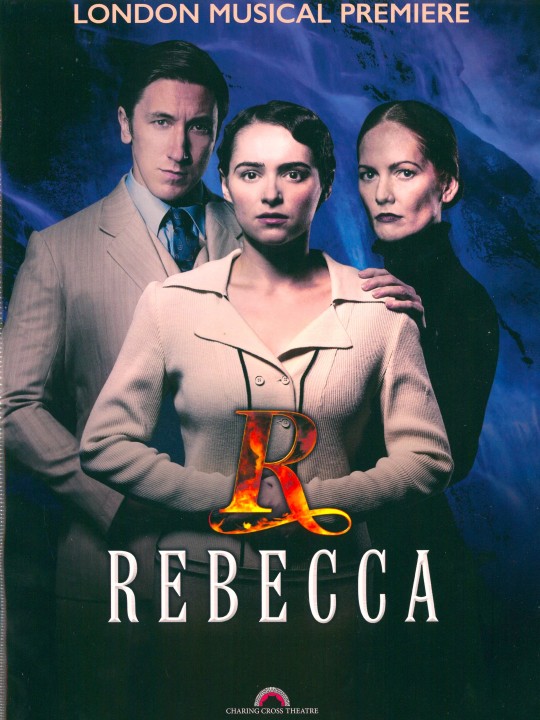

Found a programme for the London production of Rebecca das Musical on ebay, so I got it scanned in case someone would like to see. All 30 pages are attached below. It doesn't have a lot of photos, but it has full cast and song lists which I haven't seen anywhere else. Feel free to inbox me for a PDF copy that's easier to read. Enjoy!
Ich/I - Lauren Jones
Maxim de Winter - Richard Carson
Mrs. Danvers - Kara Lane
Mrs. van Hopper - Shirley Jameson
Beatrice - Sarah Harlington
Giles - Neil Moors
Frank Crawley - Piers Bate
Clarice - Emily Apps
Frith - Nigel-Joseph Francis
Jack Favell - Alex James-Ward
Ben - David Breeds
Colonel Julyan - Nicholas Lumley
Ensemble: Melanie Bright (u/s Mrs. Danvers), Rosie Glossop, Gail Mackinnon, James Mateo-Salt, Scott McClure, Tarisha Rommick, Elliot Swann
Directed by Alejandro Bonatto
Conducted by Robert Scott
Choreography by Ron Howell


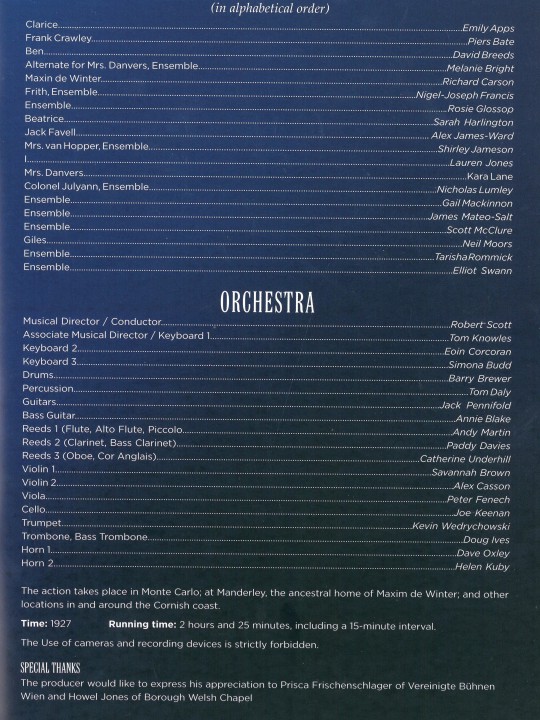
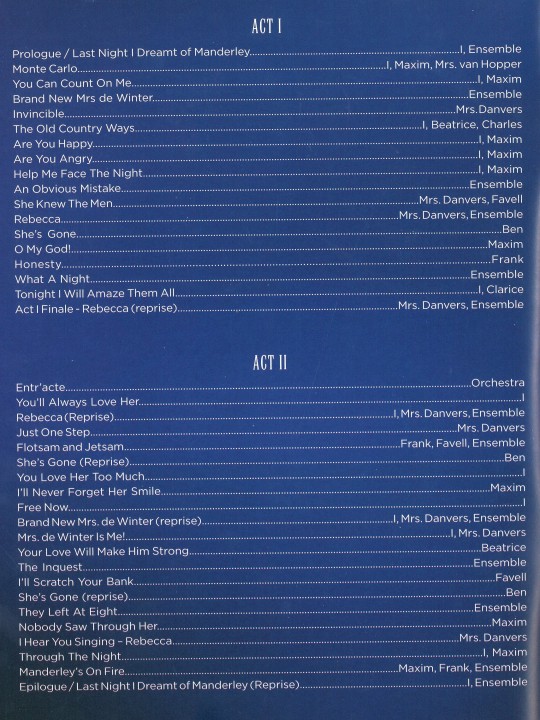
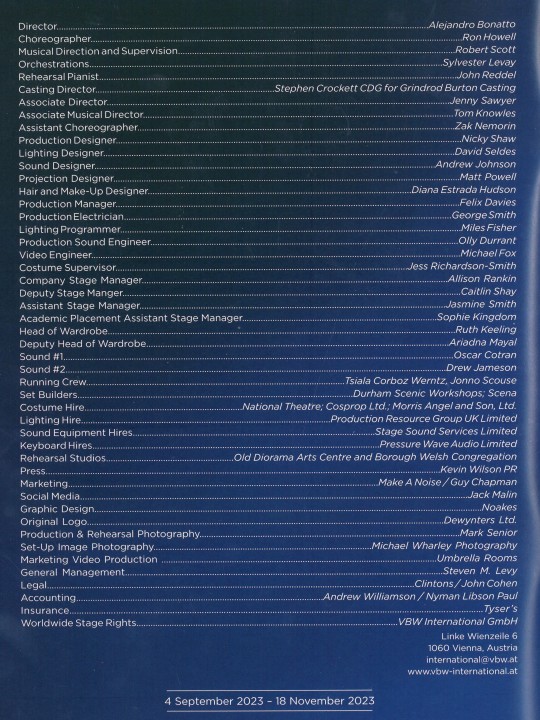

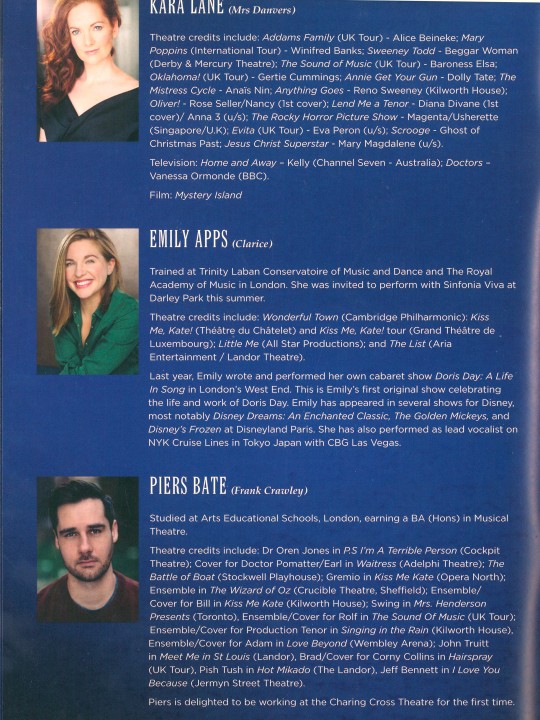


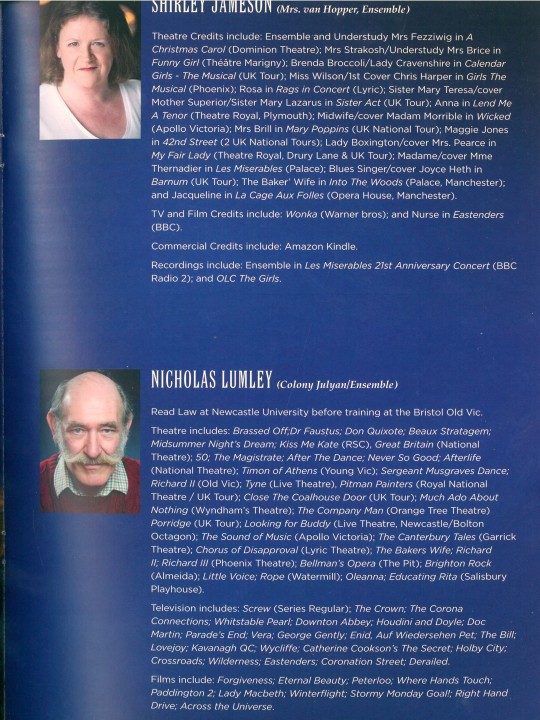
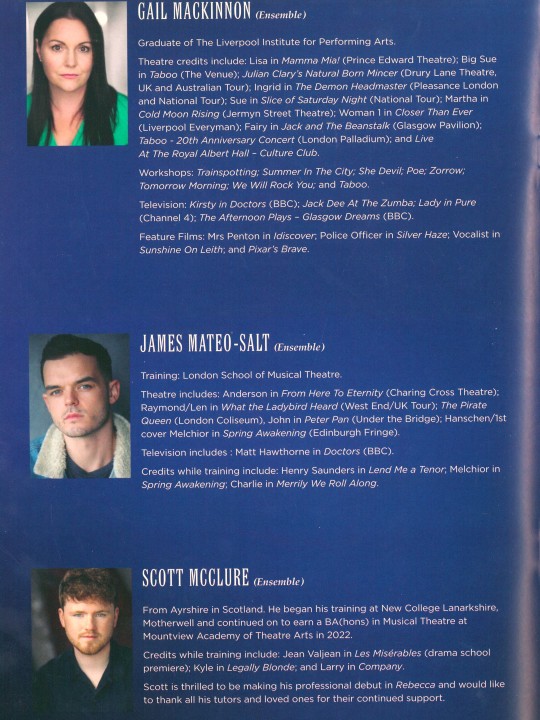
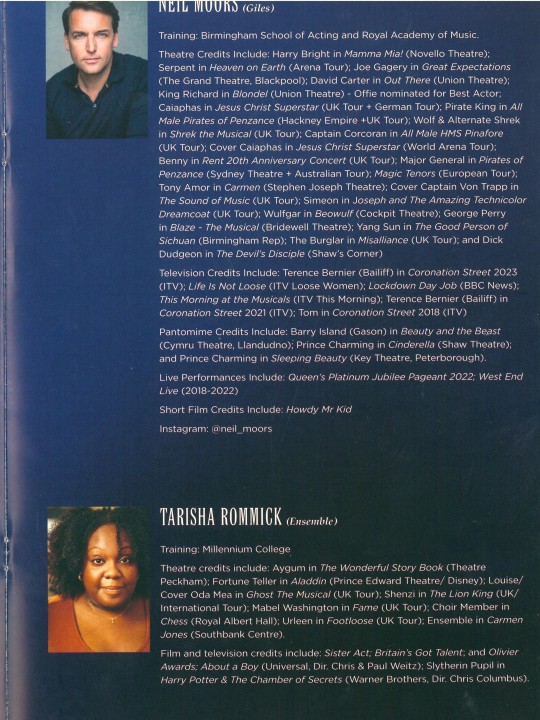
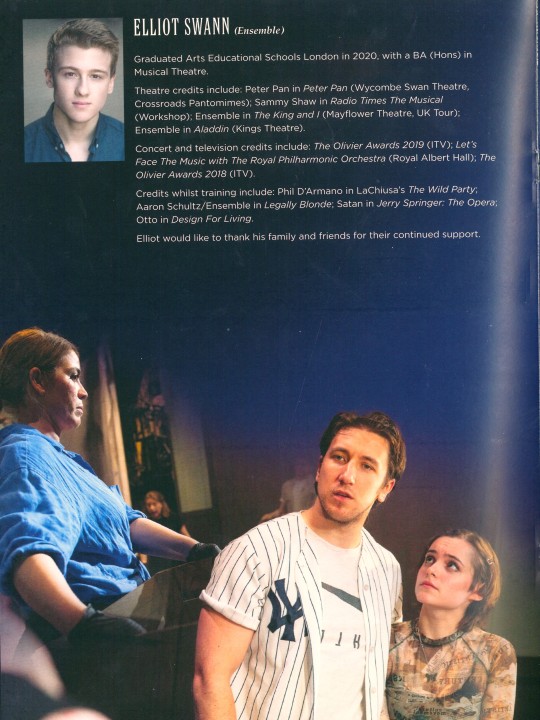

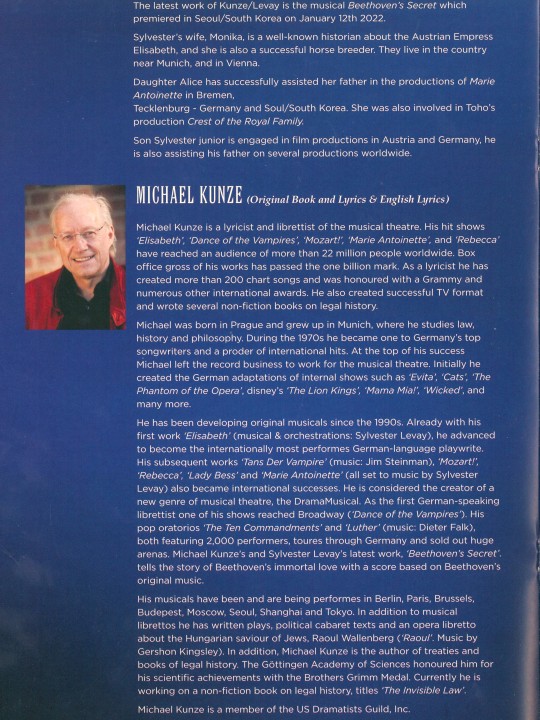
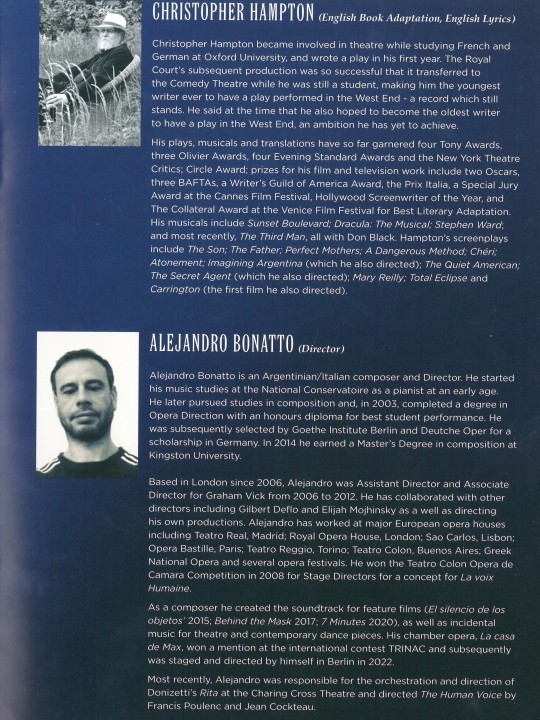


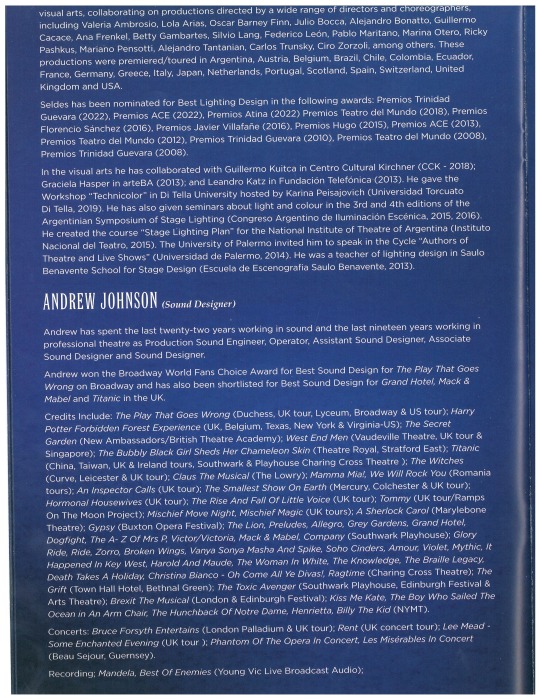

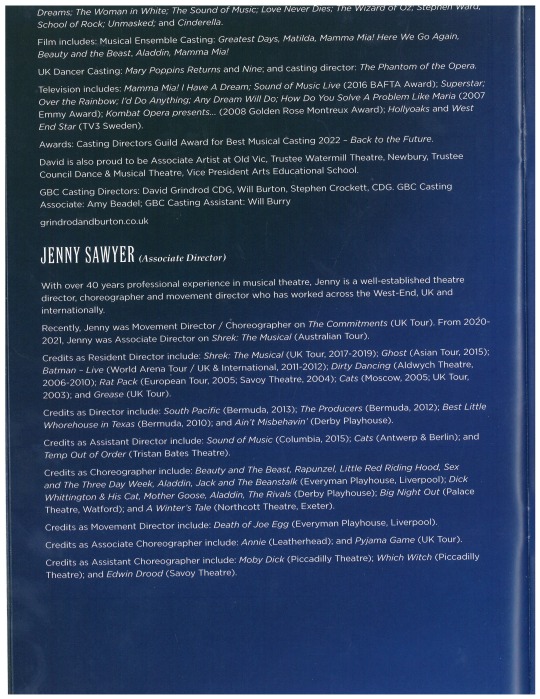
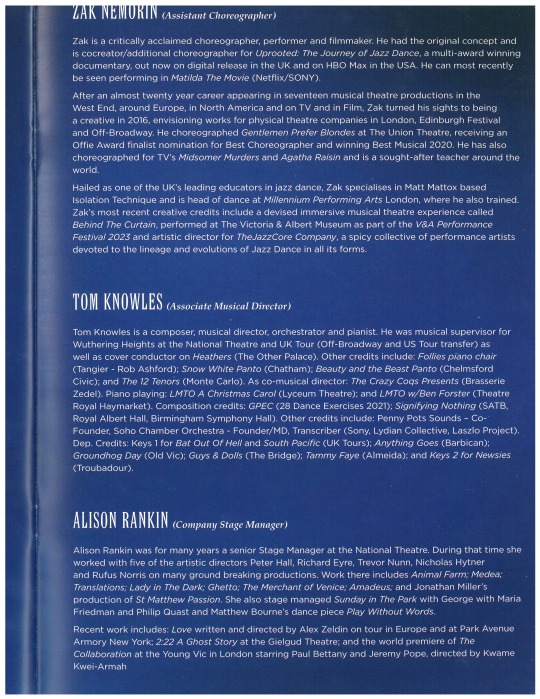
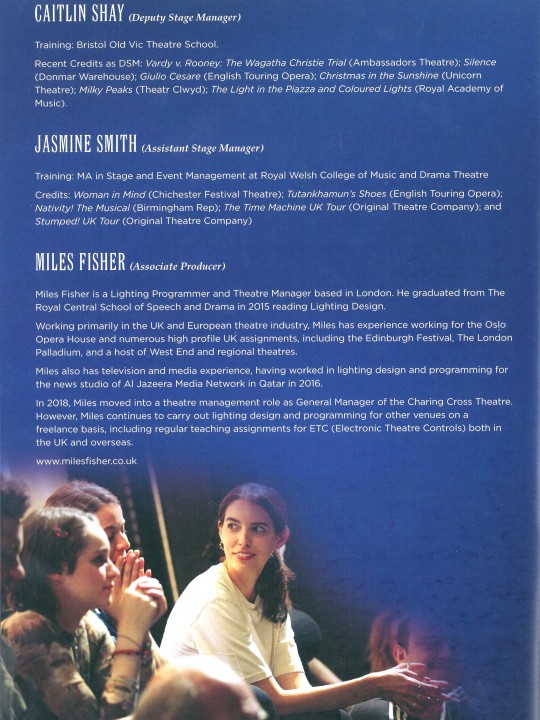


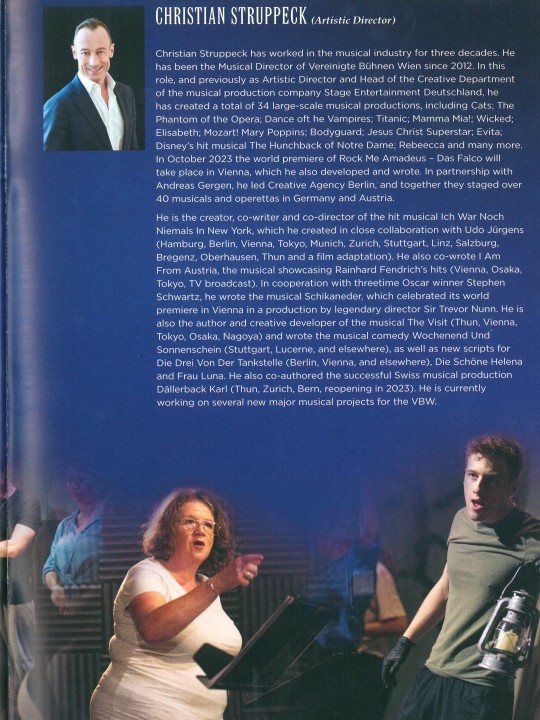

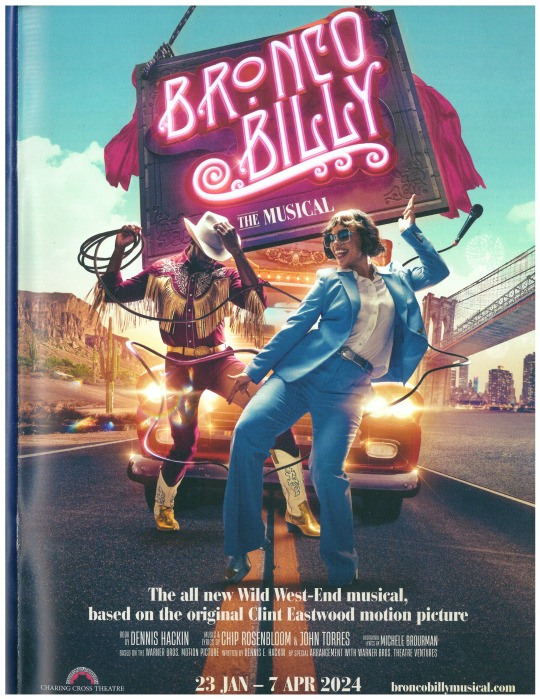
#rebecca#rebecca london#rebecca musical london#rebecca das musical#rebecca levay kunze#daphne du maurier#a manderley ház asszonya#kara lane#lauren jones#richard carson#charing cross theatre#musical theatre#european musicals
48 notes
·
View notes
Text
Hey I'm trying to find some pdfs for queer media archival (mainly because of a certain asshole), but I can't find these few. Could those who are willing help me find downloads for them? List below the cut (kinda long).
If multiple are available from one source, just list by source and provide one link per source (unless it's a pain to search or whatever). Epub is okay but pdf is preferred.
Not Found On OceanOfPDF:
WYND - James Tynion and Michael Dialynas
Homebody - Theo Parish
St. Hell Book 2+ - Lewis Hancox
Rainbow! Volume 1 - Tapas Media
Sunhead - Alex Assan
Hockey Girl Loves Drama Boy - Faith Erin Hicks
The Girl From The Sea - Molly Knox Ostertag
Across a Field of Starlight - Blue Delliquanti
The Pirate and the Porcelain Girl - Emily Riesbeck, Nora J. Barna
King Cheer - Molly Horton Booth, Stephanie Kate Strohm
Snapdragon - Kat Leyh
Witchlight - Jessi Zabarsky
If You'll Have Me – Eunnie
Unfamiliar, Vol. 1 - Haley Newsome
Junior High - Tegan Quin, Sara Quin
Lunar Boy - Jacinta Wibowo, Jessica Wibowo
Grace Needs Space! - Benjamin A. Wilgus, Rii Abrego
Bodyshy - Margot Sounack
Crumbs - Danie Sterling
Queer Heroes Of Myth And Legend – Dan Jones
Queer History A to Z: 100 Years of LGBTQ+ Activism - Robin Stevenson
Middletown - Sarah Moon
Flash Fire - TJ Klune
Heatwave - TJ Klune
Forging Queer Leaders: How The LGBTQIA+ Community Creates Impact From Adversity - Bree Fram, Liz Cavallaro
How Do I Un-remember This: Unfortunately True Stories - Danny Pellegrino
Transitions: A Mother's Journey - Elodie Durand
The Book of Pride: LGBTQ Heroes Who Changed the World - Mason Funk
The Gay Revolution: The Story of the Struggle - Lillian Faderman
Original Plumbing: The Best of Ten Years of Trans Male Culture - Amos Mac, Rocco Kayiatos, Cooper Lee Bombardier
Queer Villains of Myth and Legend: A Revelry of Queer Rogues and Outlaws Through the Ages - Dan Jones
Revolution Is Love: A Year of Black Trans Liberation - Aperture (ISBN-13: 9781597115308)
Gay Lives - Robert Aldrich
The Other Victims: First-Person Stories of Non-Jews Persecuted by the Nazis - Ina R. Friedman
Trans Kids and Teens: Pride, Joy, and Families in Transition - Elijah C. Nealy
My Brother My Sister: Story of a Transformation - Molly Haskell
Private Love, Public School: Gay Teacher Under Fire - Christine A. Yared
Raising LGBTQ Allies: A Parent's Guide to Changing the Messages from the Playground - Chris Tompkins
American Savage: Insights, Slights, and Fights on Faith, Sex, Love, and Politics - Dan Savage
Journey to Same-Sex Parenthood: Firsthand Advice, Tips and Stories from Lesbian and Gay Couples - Eric Rosswood
Out of the Shadows: Reimagining Gay Men's Lives - Walt Odets
Out of the Shadows: How London Gay Life Changed for the Better After the Act - Tony Walton
Love and Resistance: Out of the Closet into the Stonewall Era - Jason Baumann, Roxane Gay, Kay Tobin Lahusen, Diana Davies
It Gets Better: Coming Out, Overcoming Bullying, and Creating a Life Worth Living - Dan Savage
Ask a Queer Chick: A Guide to Sex, Love, and Life for Girls Who Dig Girls - Lindsay King-Miller
LGBTQ Stats: Lesbian, Gay, Bisexual, Transgender, and Queer People by the Numbers - Bennett Singer, David Deschamps
Born This Way: Real Stories of Growing Up Gay - Paul V. Vitagliano
Straight: The Surprisingly Short History Of Heterosexuality - Hanne Blank
In Search of Emma: How We Created Our Family, A Memoir - Armando Lucas Correa
The Queeriodic Table: A Celebration of LGBTQ+ Culture - Harriet Dyer
The Queer Bible - Jack Guinness
A Girlhood: Letter to My Transgender Daughter - Carolyn Hays
LGBTQ Family Building: A Guide for Prospective Parents - Abbie E Goldberg
Queer Footprints: A Guide to Uncovering London's Fierce History - Dan Glass
Please Miss: A Heartbreaking Work of Staggering Penis - Grace E. Lavery
Pride: A Celebration in Quotes - Caitlyn McNeill
How to They/Them: A Visual Guide to Nonbinary Pronouns and the World of Gender Fluidity - Stuart Getty
The Queering of Corporate America: How Big Business Went from LGBTQ Adversary to Ally - Carlos A. Ball
Real Queer America: LGBT Stories from Red States - Samantha Allen
This is a Book for Parents of Gay Kids: A Question & Answer Guide to Everyday Life - Dan Owens-Reid, Dan Owens-Reid, Kristin Russo
Queer Adolescence: Understanding the Lives of Lesbian, Gay, Bisexual, Transgender, Queer, Intersex, and Asexual Youth - Charlie McNabb
Hollywood Pride: A Celebration of LGBTQ+ Representation and Perseverance in Film - Alonso Duralde
Not Found On irc.irchighway.net/#ebooks Or OceanOfPDF:
Thieves - Lucie Bryon
Belle Of The Ball - Mari Costa
Stars In Their Eyes - Jessica Walton
0 notes
Text
THE JEWISH TERRORISM AND GENOCIDE OF PALESTINIANS IN THE OCCUPIED HOLY LAND SINCE 1948 and STILL CONTINUING TODAY BY KILLING HELPLESS AND INNOCENT CHILDREN, WOMEN, AND OLD PEOPLE, GOD FORBID, AMEN.
“If a Jew needs a liver, can you take the liver of an innocent non-Jew passing by to save him? The Torah would probably allow that. Jewish life has an infinite value.”
Rabbi Yitzhak Ginsburgh, quoted in Jewish Fundamentalism in Israel by Prof. Israel Shahak and Norton Mezvinsky, London: Pluto Press, 2004, p. 62
See also Chapter 2 in the earlier 1999 edition, available online for free:
http://www.ipk-bonn.de/downloads/Jewish_Fundamentalism_in_Israel.pdf https://pbs.twimg.com/media/CR3w3YPUwAAswq8.png:large Rabbis, Assemblyman, & Mayors Arrested For Harvesting Illegal Organs!
youtube
An error occurred. Try watching this video on www.youtube.com, o
Israel admits it harvested organs of dead Palestinians
youtube
Try watching this video on www.youtube.com,
More on organ harvesting here. September 11, 2009, Israeli newspaper Ma’ariv publishes Torat Ha’Melech, “King’s Torah” The Complete Guide to Killing Non-Jews by Roi Sharon An English translation is here:
http://didiremez.wordpress.com/2009/11/09/settler-rabbi-publishes-the-complete-guide-to-killing-non-jews/ http://coteret.com/2009/11/09/settler-rabbi-publishes-the-complete-guide-to-killing-non-jews/ Rabbi Yitzhak Shapira and his “King’s Torah” Guide to Killing Non-Jews funded by the Israeli government
September 25, 2009, The Goldstone Report
http://tinyurl.com/ydbgh7k http://www2.ohchr.org/english/bodies/hrcouncil/docs/12session/A-HRC-12-48.pdf November 2, 2009, Settlements are fertile ground for Jewish terror by Gideon Levy, Haaretz Correspondent. “…[serial killer Yaakov “Jack” ] Teitel had an organized, all-embracing worldview: Death to Arabs, homosexuals, Christians, leftists, and Messianic Jews….”
http://www.haaretz.com/hasen/spages/1125294.html November 24, 2009, Rabbi Yitzhak Shapiro publishes book funded by the Israeli government endorsing the killing of children and infants
http://www.haaretz.com/hasen/spages/1126890.html
Who Is Funding the Rabbi Who Endorses Killing Gentile Babies? Rightists rush to place ‘Jewish terrorists’ on fringe, but Yesh Din has found out some interesting facts by Akiva Eldar 17.11.2009 02:40 Updated: 3:01 PM
http://www.haaretz.com/hasen/spages/1128767.html December 12, 2009, “Death to Christians”: Hebrew graffiti next to Upper Room in Jerusalem, the Cenacle
http://www.asianews.it/index.php?l=en&art=17106&size=A “Death to Christians”
December 14, 2009, Russian cathedral in Jerusalem vandalized http://www.interfax-religion.com/?act=news&div=6737 December 16, 2009, “We killed Jesus” and “Christians out”, extremists write. Urinating on the door has become an almost daily event at the Cenacle, sacred site of the Last Supper
http://www.asianews.it/index.php?l=en&art=17130 December 27, 2009, Before Christmas Israelis steal sacred Mary’s Gate from the Church of the Holy Sepulchre.
http://palestinecry.blogspot.com/2009/12/special-palestine-cry-blog-articles-why.html December 30, 2009, Christian convert repeatedly attacked in Jerusalem, police do nothing
http://www.crosswalk.com/news/religiontoday/11624325/ December 30, 2009, Christians in Jerusalem want Jews to stop spitting on them by Amiram Barkat
http://www.haaretz.com/hasen/pages/ShArt.jhtml?itemNo=487412&contrassID=2&subContrassID=5&sbSubContrassID=0&listSrc=Yhttp://www.liveleak.com/view?i=fe8_1258413314
1 note
·
View note
Text

Kadın Derleyen Öztürk Aydın Pdf
Ön Söz: Kadın, erkeği kılıçsız zapteder ve ipsiz bağlar. Lev Tolstoy Hayvanlar dünyada kendileri için bulunurlar. İnsanlar için var olmamışlardır; siyahların beyazlar için, kadınların erkekler için var olmadığı gibi. Alice Walker
Yedek: https://www.scribd.com/document/696201800/Kad%C4%B1n-Derleyen-Ozturk-Ayd%C4%B1n
Son Söz: Dişisine kötü davranan tek hayvan insanoğludur. Jack London Kadınlar asla bir din icat etmemiştir; onlar bu çılgınlıkla lekelenmemişlerdir ve ahlakçı değillerdir. George Edward Moore
0 notes
Text
RESEARCH: AREVA REPORT BY JACK KY TAN
This report was made in response to the question: "What does an anti-racist institution look like?" “Systems are not created through resolving the differences, but by manifesting and holding differences together as multiple entangled truths. What underpins the whole conversation about racism and anti-racism is the function and failure of language. As categories, names and labels evolve, the use and misuse around words reveal a cynicism about language and a widening of the semiotic gap between form and meaning in words. Language becomes both the vehicle and the barrier. “ Link to report https://iniva.org/wp-content/uploads/2023/01/AREVA-Report-Jan-2023-CVAN-London-iniva-Jack-Ky-Tan-1.pdf



I thought it was very interesting that the response to the questions that were discussed among them, the report sums it up in a poet style. I think this is very effective and yet it is still simple the use of less words creates a deeper understanding of the issues discussed. I would like to adapt this technique for this project.
0 notes
Text
Jack London - Bir Kuzey Macerası PDF indir
Jack London – Bir Kuzey Macerası PDF indir

Bir Kuzey Macerası isimli ve Yazarı Jack London olan kitabın pdf dosyasını paylaşma amacımız kitabın tanıtımını yapmaktır. Kitabın tanıtım halini buradan kontrol ederek kesinlikle orjinalini alıp daha iyi bir sonuca varmış olursunuz. Kitap olarak çözmenin PDF olarak çözmekten daha verimli olduğu tespit edilmiştir.
Paylaşımda bulunduğumuz Bir Kuzey Macerası bu kitabın orjinalinin tanıtılması…
View On WordPress
#Bir#Bir Kuzey Macerası#Bir Kuzey Macerası pdf#Bir Kuzey Macerası pdf indir#Jack London#Jack London pdf#Jack London pdf indir#kitap pdf indir#Kuzey#Macerası#pdf indir#TÜRKİYE İŞ BANKASI KÜLTÜR YAYINLARI#TÜRKİYE İŞ BANKASI KÜLTÜR YAYINLARI pdf#TÜRKİYE İŞ BANKASI KÜLTÜR YAYINLARI pdf indir
0 notes
Text
Jack London – Kızıl Veba
Jack London Kızıl Veba hastalığın uygar toplumu nasıl yok ettiğini anlatıyor. Kitabın baş karakteri Profesör Smith yani Granser, salgından sonra oluşan ilkel yaşamı görmüş son kişi. 2070’li yıllarda, artık son zamanlarını yaşayan Granser torunlarına her ne kadar uygar toplumu anlatsa da hiç görmedikleri medeniyet onlara anlamsız geliyor ve dünya kendini tekrar ediyor.
2000’lerin çeyreğinde, başlarda önemsenmeyen bir hastalık ölümlere sebep olurken, kısa bir süre sonra olayın nasıl şekilleneceğini kimseler öngöremiyor. Bedenlerindeki kızarmalarla kendini gösteren salgın bir anda bambaşka bir seyre bürünüyor ve önüne gelen ne varsa kasıp kavuruyor. Bu esnada, başlarda itidal varmış gibi görünse de kendini tecrit ile kurtarabilen pek az insana rağmen kalanlar sokaklara dökülüyor ve bir yağma düzeninin ilk izleri görünmeye başlıyor.
Olayların son şahidi olan profesör Smith, kendi gibi 400 kadar insanla bir üniversiteye sığınıyor ancak onlardan da geriye sadece kendisi kalıyor. Bir medeniyetin çöküşüne, bir kıyamete şahit oluyoruz bütün ürkütücülüğüyle. Kızıl Ölüm’ün gelmesiyle birlikte dünya mutlak ve geri dönüşsüz olarak dağılıyor paramparça oluyor.
Geride kalan bir avuç insan, yıkılan bir medeniyet, değişen yaşam koşulları; ilkelleşen toplum, dil, sosyal alışkanlıklar .. Smith ya da torunlarının onu çağırış şekliyle Granser, tek başınalığından sonra kendi gibi bir başkalarının da olacağına dair inancını korumaya çalışarak arayışa koyuluyor.
“Toprağıyla, deniziyle, göğüyle bütün gezegene hâkim olan, kendisini tanrı yerine koyan bizler.”
“İnsan eskiden beri metafizik bir kavram olarak mutlak adalete inanır ama anlaşılan o ki evrende adalet diye bir şey yoktur.”
Kaynak: https://www.e-kitapstore.com/jack-london-kizil-veba
#kızıl veba#jack london#kitap#kitap alintilari#kitaptan alıntı#kitapsevgisi#kitapkokusu#e-kitap#ekitap#pdf indir#book review#book
0 notes
Text
Typesetuary Day #11

Up next: The Call of the Wild by Jack London. I made this typeset in two sizes: letter folio and letter quarto! You can find both pdfs for FREE in my library! (Personal use only!)
So yeaaaaah, I actually typeset this book as letter folio first, but it was quite a short book, coming out at less than 100 pages. I decided to make a second version at letter quarto for those that want a book with a bit more thiccness to it 🫣😆
#The Call of the Wild by Jack London#the call of the wild#jack london#typesets#typesetting#bookbinding#book design#book#typesetuary#11
8 notes
·
View notes
Note
Please drop the erotic horror quotations
Anon I am (as platonically as you'd like) smooching you on the lips SO I'm a bit knackered and a bit tipsy so I am giving more broad sources than specific exact quotes but I HIGHLY recommend all of this and I should be able to get you a pdf of all of them if searching Google scholar does not work for whatever reason :D xx
For the eroticism of Horror as a genre you want Gender, Genre, and Excess by Linda Williams (1991) as a primer, and after that to start you off (because it always comes back to her work) my favourite pieces include Like and Lycanthropy (Stafford, 2020, in New Queer Horrror ed. Elliot-Smith), Is the Rectum a Grave? (Bersani, 1987), Masculinity as Spectacle (Neale, 1983). You will also enjoy watching An American Werewolf in London!!!
From my dissertation - "if, as Bersani asserts, sex is any sufficiently intense stimulation (p217), then [werewolf] transformation is not only sexual, but is sex itself; that is, the distortion and transgressive transformation of a lycanthropic body is a fantastical equivalent reflection of the transgender human body."
You may also enjoy Harry M. Benshoff, Susan Stryker, and Jack Halberstam for expressly queer takes on these concepts!
Eroticism in horror always circles back to Williams' work tbh, it's about being invited expressly to look at a body and experience a visceral, physical, and often transgressive response about it and it is VERY good
37 notes
·
View notes
Text
Jack the Ripper: A Statistical and Typological Analysis

Introduction
Jack the Ripper was an uncaught British serial killer who operated in London from August of 1888 to November of the same year. He has five canonical victims, all of which were prostitutes. The confirmed victims include Mary Ann Nichols (31st of August), Annie Chapman (8th of September), Elizabeth Stride (30th of September), Catherine Eddowes (30th of September) and Mary Jane Kelly (9th of November).
Typology of Jack the Ripper
Serial killers can usually be organized into six typologies each with their own unique incentive, ideas, thoughts and methods of killing. The varieties of these types are the organized killer and disorganized killer and the main types are the visionary killer, the mission-oriented killer, the hedonistic killer (thrill, lust and comfort) and the power-oriented killer.
Though the killing of prostitutes may suggest a mission-oriented motive, the letters loosely suggest a thrill variety hedonistic killer (he gained obvious enjoyment of taunting of the police and the "Dear Boss" letter had a generally jovial or humorous attitude) and crime scene characteristics match the lust variety (controlled crime scene, overkill, specific victim and body mutilation after death).
The organized vs. disorganized concept is another system of criminal typology that uses crime scene analysis. Using this system we can use conjecture to determine certain personality traits (organized killers might have a higher IQ, for example). I’ll use this rating system to figure out his orientation on the O/U scale:
-Victim known: 0
-Stranger targeted: 1
-Poisoned: 0
-Chaotic scene: 0
-Controlled scene: 1
-Weapon planned: 1
-Weapon left: 0
-Body transported: 0
-Act focused: 1
The answers to this checklist suggest an organized typology by a minor amount. Though the closeness of results his organization and calmness during the course the crime suggests the result is accurate.
For personality factors we can use the OCEAN model:
-Openness: Moderate to high. Somewhat open and creative. He named himself and was one of the first serial killers to send letters. -Consciousness: Unknown. Likely moderate to low. He was organized during the course of the murders. -Extraversion: Unknown. Likely low. Considering the statistical likelihood of feelings of loneliness he'd likely have low social adequacy and social introversion. -Agreeableness: Low. Uncooperative and hostile. Partakes in crime behavior, taunting police and murder. -Neuroticism: Mid to low. Calm and unemotional. Was able to calmly avoid police and surgically remove body parts of victims precisely without anxious slip-ups.
An extra cluster will be included in the next section not discussed here. Specifically statistical analysis of prostitute homocides.
Speculation, Comparisons to Other Killers, Statistical Traits
We know that the Zodiac Killer could be profiled into both the visionary and hedonistic category based off motivation. However, what could possibly be the cause for these behaviors and what could be gleaned from these classifications?
From statistical analysis of prostitute murderers and the earlier typological analysis it's most likely he had these traits :
1. Poor academic record. [Statistics]
2. Average to high intelligence. [Statistics]
3. Highly lost in thought or a daydreamer. [Statistics]
4. Unsteady employment and holds low-level jobs. Though he was most likely employed at the time of the murders due to most of his killings taking place on weekends or holidays. [Statistics & Conjecture]
5. Chronic feelings of isolation or loneliness. [Statistics]
6. Was in his early thirties. This indicates a most likely correct witness description of Jack. [Statistics]
7. Even if he had poor academic performance he was most likely educated considering the use of a paragraph indent and correct spelling in the "Dear Boss" letter. This supports the idea has had parents with stable work. [Conjecture]
8. Has a controlled mood in general or during the crime. [Typology]
9. Follows the crime in news media. [Typology]
10. Parent's work was generally stable. [Typology]
11. If he was a lust killer he most likely gained sexual gratification from murder, killed strangers, planned the murders and was highly organized. [Typology]
12. If he was a thrill killer he likely enjoyed of the thrill of killing itself, killed strangers, created processes for murder and was highly organized. [Typology]
13. Uncooperative, calm affect, introverted, moderately hardworking/organized and somewhat creative. [OCEAN]
Outro
Even over one-hundred and thirty-three years later Jack the Ripper is still one of the most discussed Serial Killers in history. The shadowy moustached figure stalking the misty streets of London's name will most likely always be Jack, however, even now we can possibly still shed some light on who was behind the name Sources:
https://www.casebook.org/ripper_letters/
https://www.ojp.gov/pdffiles1/nij/grants/198117.pdf
https://www.biography.com/crime-figure/jack-the-ripper
https://www.casebook.org/victims/
https://europepmc.org/article/med/30544084
https://www.researchgate.net/publication/307819660_The_Traits_and_the_Thrill_of_Serial_Killers
https://www.marshall.edu/forensics/files/Baber_Seminar2014_ODcsp.pdf
(Note: I am not a psychologist, just interested in criminology)
36 notes
·
View notes
Photo
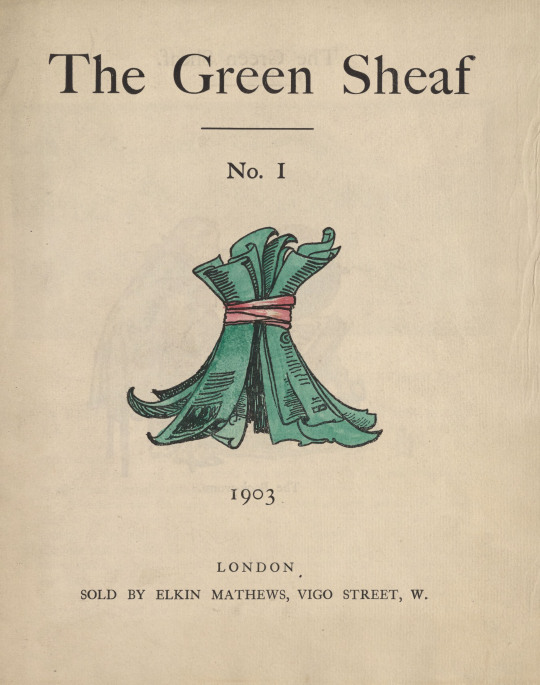
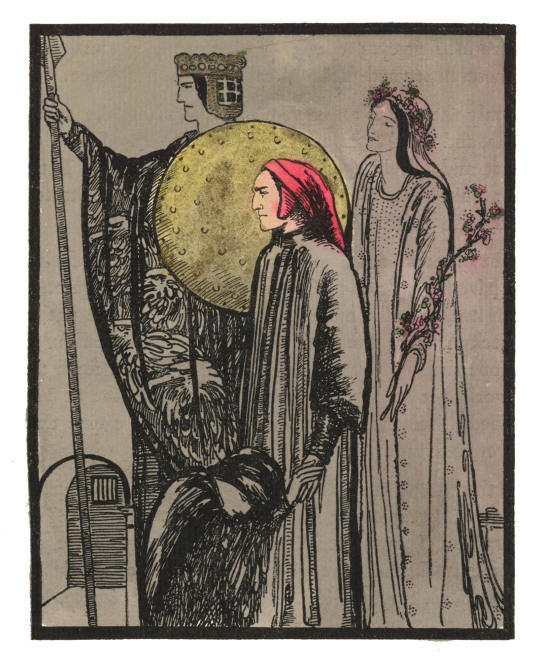
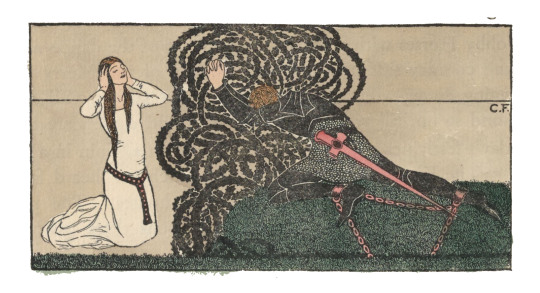

Hey, so, great news, someone finally uploaded every issue of Pamela Colman Smith’s Green Sheaf magazine to archive.org.
It’s all available for free in high resolution, and I did some tasteful chopping and stitching to put together a single PDF with all of the content from every issue.
The Green Sheaf has never been reprinted, so, I went ahead and made some physical copies as well (it’s kind of expensive, sorry, but it’s full color and it looks nice).
The illustrations in this post are by Pamela Colman Smith, Cecil Frank, and AE, in that order. Didn’t know AE was an illustrator? Me neither! Every page of this book is good.
You can read my full introduction to the book after the break.
Pamela Colman Smith (known to her friends as “Pixie”) secured her place in the history of Western esoterica in 1909, after she was commissioned to illustrate a new tarot deck by the author and mystic A.E. Waite. The illustrations were instantly iconic upon release, and their popularity was greatly bolstered by Waite’s failure to copyright the work in the United States. The cards, henceforth in the public domain, were widely circulated in new decks, in books, on merchandise, album covers, and so on and so forth - unlikely fuel for the American consumerist behemoth. Over a century and change, the Waite-Rider Tarot’s visual style has been firmly cemented in popular culture as a stock aesthetic of the esoteric and occult.
In The Green Sheaf (1903 - 1904), we can see some of the artistic foundations of those cards being developed. Ancient archetypes processed by modern symbolists; forms and figures plucked from folklore and myth, rendered in bold lines and flat colors. As editor, Pixie commissioned work from her various social circles in London; she drew on previous connections from A Broad Sheet (another arts magazine, co-edited with Jack Butler Yeats), as well as the Lyceum Theatre Group, the Hermetic Order of the Golden Dawn, literary celebrities from the Irish & Celtic Revivals, and gay rights activists from the secret Order of the Chaeronea.
As she developed her magazine, Pixie regularly gathered her friends for weekly salons at her studio in Chelsea; Arthur Ransom, a contemporary English writer, described one of these nights in a chapter of his book of essays, Bohemia in London (1907).
“She welcomed us with the oddest shriek,” Ransome recalls of meeting Pixie for the first time, in 1901. “It was the oddest, most uncanny little shriek, half laugh, half exclamation. It made me very shy. It was obviously an affection, and yet seemed just the right manner of welcome from the strange little creature, ‘god daughter of a witch and sister to a fairy’ who uttered it.”
In a ‘mad room out of a fairy tale,’ with its walls covered in drawings and paintings from around the world, and curated with such fanciful artifacts and baubles as to ‘have the effect of a well designed curiosity shop,’ Ransome was treated to an evening of poetry, storytelling, and song. Pixie and her friends performed for one another amid the smoke of cigarettes and thick incense; the cocktail of the evening was the ‘opal hush,’ an amethystine blend of lemonade and red claret. A visitors’ book was kept, signed by the attendees with caricatures and rhymes, the pages ‘used as a tournament field’ of jest between friends.
After this introduction to the studio, Ransome made a point to return each week to Pixie’s parties. “Always we were merry. The evening was never wasted. There I heard poetry read as if the ghost of some old minstrel had descended on the reader, and shown how the words should be chanted aloud.”
The spirit of Pixie’s salon was distilled, like an alchemist’s solution, into The Green Sheaf. It ran for 13 hand-colored issues. Included in its pages were not just contemporary voices, but fragments from the Gothic-Romance-era masters such as William Blake, Anna Laetitia Barbauld, and John Keats. The magazine made themes of dreaming, spirituality, and a longing for a world to which we can never return.
In contrast to the popularity of her Tarot designs, Pixie’s Sheaf fell immediately into obscurity; prior to this volume, it has never been collected or republished. With that grievous error corrected, it is my pleasure to present to you, thunderously and without mercy, the complete Green Sheaf.
May it be enshrined in crystal, evermore.Aladdin Collar,
Founder, the American Eldritch Society for the Preservation of Hearsay and Rumor
#pamela colman smith#tarot#occult#esoterica#aesthetic periodicals#art#literature#fantasy#dream#wonder#fae#pixie#poetry#vintage illustration#1900's
107 notes
·
View notes